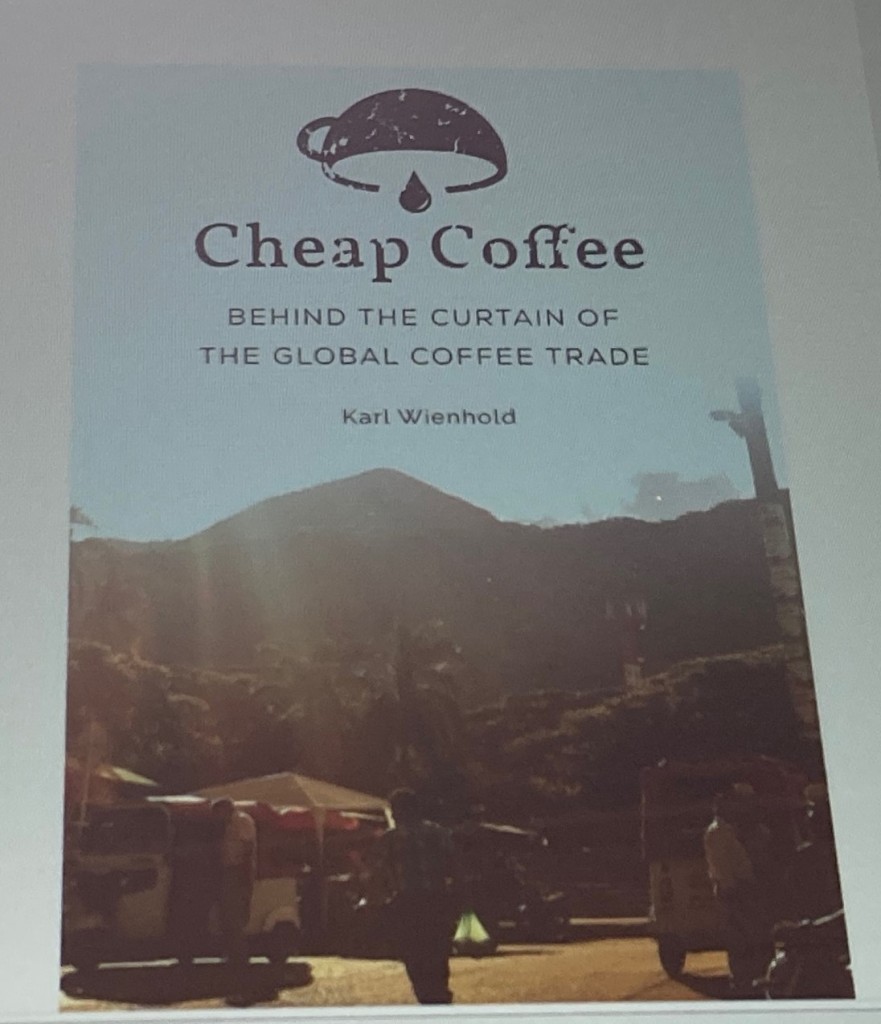If you choose to read one publication about coffee this year, I suggest it is the new book by Karl Wienhold called ‘Cheap Coffee: Behind the Curtain of the Global Coffee Trade’. This book provides an overview of how and why the coffee industry as it is today is not sustainable – as the headlines on the website suggests:
”The green coffee value chain is broken….. Bold ideas and actions are needed to fix it. But a thorough understanding of the context is required for any efforts to be successful.”
The book explains the different elements of how the coffee industry works, highlighting the inequalities that exist, the issues faced by different stakeholders, and the complexity of the issues that face the industry. Importantly the author raises lots of questions, and asks the reader to raise questions about what a sustainable, egalitarian, constructive coffee supply chain would look like.
There is no easy response to this question or others, as is highlighted in the book, the nature of the coffee industry is complex and will require a lot of effort from all involved to foster change:
“It is the responsibility of the entire industry and supply chain to economically incentivize the activities and conditions that it wishes to promote. Producers, many of whom live in poverty and most of whom control less economic resources than the consumers of their products, should not be expected to take on the responsibility and cost of improving environmental sustainability. If you want a farmer to implement shade-growing, humane treatment for workers, and other sustainable practices, you must be prepared to pay for it.” (p.350)
There are so many quotes from the book I want to refer to, but I think the one above is useful in reinforcing the point about responsibility for changes comes from all those involved, including the consumers. As the author states: consumers ‘need to know what real sustainability looks like in coffee, what exactly they need to demand from suppliers, and how to verify it and cut through the fog’ (p.384). I think this book is a great starting point for consumers to understand the problems with coffee industry and inequalities that exist, but also that there is a role for them to promote change.
It also highlights how what sustainability means for the coffee industry is to some extent uncertain, and this is something I’ve been exploring in our recent research project focusing on Indonesia. The understanding of sustainability and how to be more sustainable differs depending on the context, and often the stakeholder you are talking to. The author makes the important point that:
‘coffee companies must ask themselves if they are investing in ensuring sustainability, or just creating the impression of working towards sustainability. Both are effective, but one is cheaper’ (p.281). And I would add to this to say that one is more effective than the other, and it is important efforts are made to work towards encouraging all actors in the coffee industry to recognise the importance of fostering sustainability in the industry, not just to be able to put labels on products that indicate they are produced more sustainably, but to really ensure that the industry has a sustainable future for the millions of families involved.
I usually deliver various lectures to students on the coffee industry and issues related to sustainable coffee, and this will most definitely be used added to the reading list. For those just starting to explore how the industry works, way coffee is traded, and the price of coffee, but this book managed to explain everything in a really accessible manner, which I think will have wide appeal.
I’ve often argue how the coffee industry is a useful lens to explore so many different geographical concepts and processes, and for me this book reinforces that point, from globalisation, agricultural change and climate change to trade, labour issues, sustainable development and more. Hopefully one day I will get the opportunity to teach a whole module on coffee to explore some of these issues.
I have now digressed from the point of this blog post which was to highlight how interesting and useful I found this book. There is no one solution to the challenges facing the coffee industry, but a more collaborative approach that recognises these problems need addressing, and a commitment to trying to support a sustainable industry is a good start.



Thanks to the briefly book review of Jennifer Ferreira, I now get to know a great book for my research on Coffee business
LikeLike